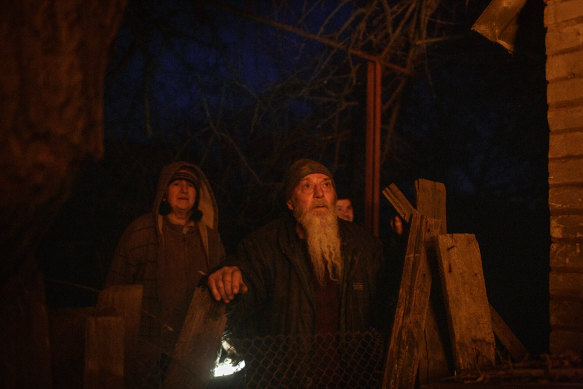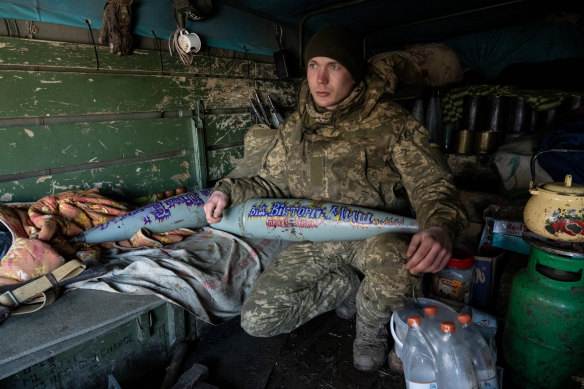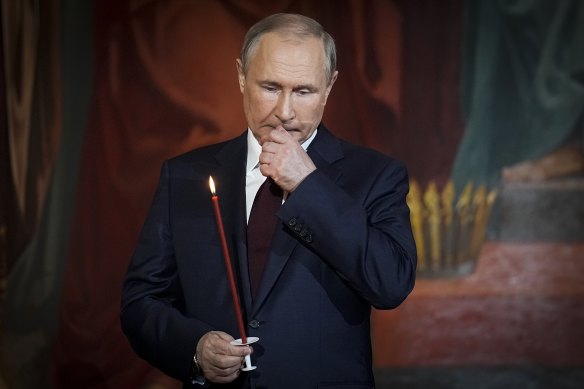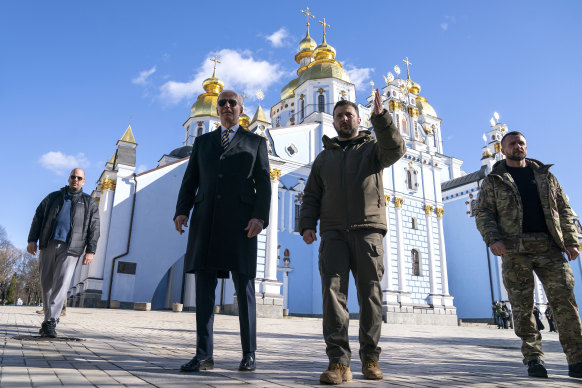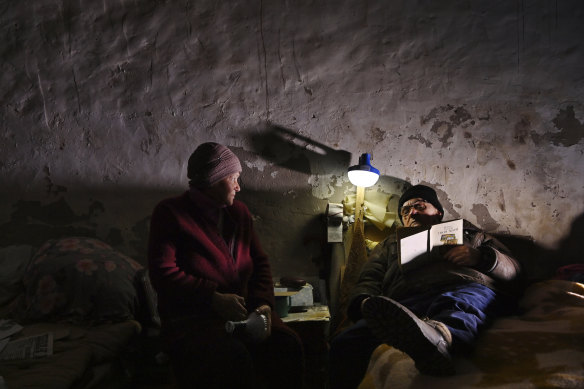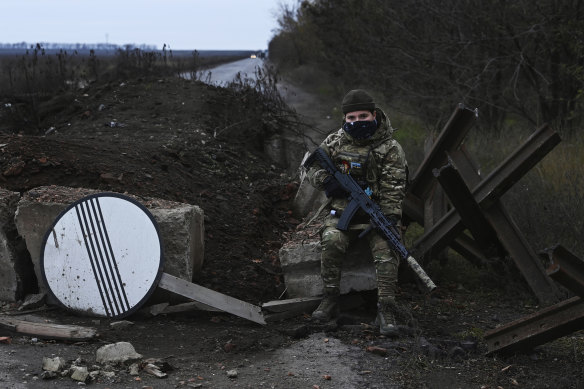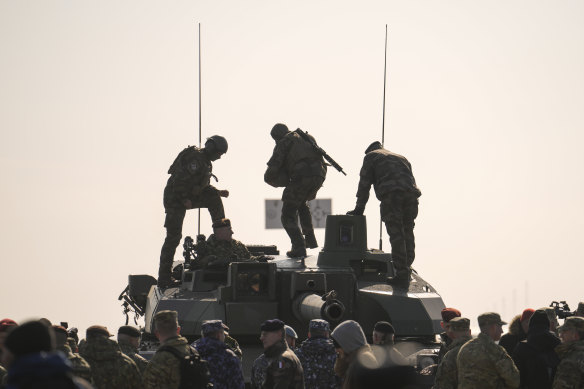Is anyone winning Putin’s war in Ukraine – and how might it end?

Russia is unleashing fresh troops in the war Putin has to win. Can Ukraine keep up its momentum or will Russia grind them down? And could it yet spiral into a wider war?
The invasion that was meant to take days is now a year old. Kremlin officials were reportedly so confident of victory when Russia invaded Ukraine in early 2022 that generals were told to pack their medals and dress uniforms for the victory parades in Kyiv that were surely just weeks away.
Instead, the world – and Russian President Vladimir Putin himself – learnt that decades of corruption had hollowed out Russia’s vast army. Some weapons were practically antiques. Food and supplies had been left to expire. Training was poor. Even bullets were scarce. Meanwhile the Ukrainians, who Putin had been sure would surrender, were remarkably fierce and well-trained – and they were winning back their land.
Now, as the winter snow thaws, both sides are unleashing fresh attacks. Russia is moving first, before more powerful Western weapons can reach Ukraine. As many Russian troops as those initially sent over the border in 2022 are joining the frontline, starting a fierce new stage of the conflict. And Putin has issued a new threat to the West, suspending (though not entirely withdrawing from) the last nuclear arms treaty with the United States.
So, with a death toll already in the hundreds of thousands and China stepping forward with its own “peace plan” (even as it mulls supplying weapons to Russia), is either side winning? And how might all this end?
On a map, this is what the war looks like after a year, ground down to a fierce south-eastern front about 1200 kilometres long.
Back in late February 2022, when Putin ordered a sudden all-out invasion of Ukraine, Russian troops attacked in a “pincer” (below left): from the south, where Russia had seized Crimea in 2014; from the east, where the war of the Donbas with Russian separatists had long simmered under a shaky ceasefire; and from the north over the Belarusian border, striking for Ukraine’s capital, the historic city of Kyiv.
For weeks the world speculated Kyiv would fall. The Russian military machine was, after all, far bigger than its neighbour’s, then boasting some 800,000 standing troops compared with Ukraine’s 200,000. And Russia’s notorious mercenary group Wagner was already in the streets hunting for Ukrainian President Volodymyr Zelensky. But Zelensky didn’t flee. And Ukraine pushed back, blowing up bridges and Russian tanks as civilians took up arms.
By Christmas, after a September lightning offensive, Ukraine had reclaimed more than 74,000 square kilometres of territory (above right). In nearly every liberated town they found evidence of Russian atrocities: civilians raped and murdered; children taken over the border for forced “re-education”; cultural icons destroyed. Ukrainian momentum grew.
Then winter came, freezing the war in a slow-moving but violent fight over the south-east. Putin is said to have radically scaled back his plans to take Ukraine outright (at least for now), although missiles still fall as far away as Lviv in the west. Yet the war is not in a stalemate either, as retired Australian major general Mick Ryan notes. Both sides still have a lot of strategic room to move – and Putin a lot more up his sleeve.
People watch a home burn after Russian shelling in Bakhmut on January 26.Credit:Getty Images
How is the next stage of the war unfolding?
The small eastern town of Bakhmut is at the centre of one of the war’s bloodiest battles. Russia has been trying to drive out the Ukrainians since May, sending wave after wave of men at the city – and recording thousands of casualties. But experts say Bakhmut’s value is more for propaganda than strategy. Putin desperately needs a win. Likewise, the rallying cry “Bakhmut holds” has gone wild on Ukrainian social media, though Ukrainian soldiers on the ground say they are exhausted and outgunned.
These are not well-planned attacks by the Russians, says ANU military expert Charles Miller. “This is a World War I-style meat grinder.”
Bakhmut could be a useful step in seizing the Donbas outright – that’s the mammoth task Ukrainian intelligence says Putin has ordered his generals to achieve by March.
But the offensive is unlikely to come in one sudden surge along the frontline, experts say. It has taken the Russians months to advance the 30-odd kilometres from Popasna in Luhansk to Bakhmut. And though Russia is mobilising some 300,000 new troops, Western analysis suggests many are already in play. So far, they’ve been shoring up Russia’s defences and supply lines and looking for openings.
Russia may be planning to push down from the north and up from the south – a claw cutting off Ukrainian supplies. Or they might try to divert defenders from the east by reopening another front (Ukrainians are watching the north closely). “That’d be a smart thing to do,” says Miller. “Of course, we haven’t seen many smart decisions from the Russians so far.”
Ukrainian civilians are evacuated from fighting near Bakhmut on February 18. Credit:Getty Images
Last year, Wagner mercenaries were able to plug gaps and seize territory where the regular Russian army failed, but experts say their usefulness may be fading – most of their numbers are now conscripts from Russian jails.
Ukraine, meanwhile, has to ward off Russia’s latest offensive without running down the resources it needs for its own. Sir Lawrence Freedman, a war studies expert at King’s College London, says strengthened Russian defences plus boggy ground have so far stopped Ukraine from following through on its September offensive. But it is pushing in on a key Russian supply hub in Luhansk. And, under its “offence is the best defence” strategy, Ukraine may yet mount another push in the south, possibly to recapture Melitopol.
His friend was killed in combat two days into 2023, shortly after wishing his family a happy new year. “But they know he didn’t die for nothing.”
Many analysts stress that Ukraine still has momentum. This is not the same army caught unprepared by Russia’s seizure of Crimea in 2014, but a force seasoned by eight years fighting separatists, with NATO training and Western intelligence to guide their attacks. “Ukrainians fight for their very existence,” says Katarzyna Zysk, an expert on the Russian military at the Norwegian Institute for Defence Studies. “We can’t expect they’ll just give up.”
Ukrainian-Australian Stefan Romaniw recalls what his friend, a father of five, told him when contemplating whether to fight for Ukraine. “‘If we lose,’ he said, ‘my kids are going to ask: Dad, what did you do?’ So he went to the front.”
His friend was killed in combat two days into 2023, shortly after wishing his family a happy new year. “But they know he didn’t die for nothing,” says Romaniw, recently returned from a trip helping build shelters in Ukraine. “I see that everywhere over there. Ukrainians know they’ll win. Because they have to.”
In the southern Donbas region on February 19, a Ukrainian artillery team member holds a captured shell ready to load into a cannon captured from Russian troops in Kherson. Credit:Getty Images
Does each side have enough weapons to stay in the fight?
In late 2022 the US, at last, agreed to send Patriot defence systems to help Ukraine shoot down long-range Russian missiles, and Zelensky is hoping for British fighter jets, too. (The US, Germany and others are also sending advanced Leopard tanks for Ukraine’s ground assault.) But Ukraine is firing more ammunition every week than the West can produce in factories.
Russia’s vast arsenal is also stretched, says Zysk. (The country has lost more than half its operational tanks.) Western sanctions make it harder for Russia to get many of the electronics its war industry needs, though it has already bought weapons from North Korea and drones from Iran, and US intelligence says its ally China is considering sending “lethal support”.
Clive Williams, a former ADF military intelligence officer, calculates that Russia is “banging away” 15,000-odd artillery shells a day, “whereas Ukraine is probably using 5000 – again, an enormous amount. But that’s Russian strategy: destroy the enemy, destroy the ground, rebuild later.” And while Russia did switch to long-range bombing and attacks on civilians once it hit resistance, in many ways it continues to “plod along, spending its resources – and lives”.
NATO says about 15,000 Russians were killed just in the war’s first month – roughly the number the Soviets lost over 10 years in Afghanistan. A year in, closer to 200,000 Russians are estimated to have been killed or seriously injured. (Ukrainian casualties are also thought to be more than 100,000.)
“Russia did not plan for this kind of war,” says Zysk. An increasingly isolated Putin made the decision on his own; warnings from nervous generals were waved off, and most officials kept in the dark until he gave the order. Many soldiers didn’t even understand that their so-called “short training exercise” or “three-day liberation” was an invasion until they were over the border.
“My father reminded me the Japanese attacked Pearl Harbour [in World War II]. That wasn’t logical either.”
Not long after the war began, Australian-born Lubomyr Lawriwsky fled Ukraine with his Ukrainian wife Yuliia and baby son. They trekked much of the way to the Polish border on foot in the freezing cold. Before the bombs started to fall, no one in Ukraine seemed to believe the troops on the border would really invade, he says. “Because it seemed so stupid in the 21st century,” explains Yuliia from their new home in Melbourne.
But Lawriwsky had a bad feeling. “My father reminded me the Japanese attacked Pearl Harbour [in World War II]. That wasn’t logical either,” he says. Indeed, the Pearl Harbour attack is now seen as a calamitous mistake by the Japanese, drawing the US into the war.
Zysk also sees Putin’s invasion as a mistake, but a mistake with its own logic – a “colossal failure of intelligence”. Putin underestimated not just Ukrainian resistance but the Western backlash. Yet she warns Russia shouldn’t be underestimated itself, however badly it’s fighting. Not all the army is reflected in the shambolic chaos mocked on Western social media. Russia still has trained fighters. And Russia has a much bigger population to draw on, Miller says, even if another round of conscription wider than the unpopular call-up in September would create political headaches for Putin. “I don’t think Ukraine have many more cohorts left to draft.”
Russian President Vladimir Putin attends an Orthodox Easter service two months after invading Ukraine.Credit:AP
How might it end? Could Putin fall?
Predictions have been proven wrong again and again in this invasion. But historians say wars tend to end along certain lines: with total victory, or a negotiated peace or some kind of stalemate. Many pieces are moving on the chessboard, says Zysk, that could yet tip the scales for one side or the other.
So far, the war has hinged on how badly the Russians are fighting, how fiercely the Ukrainians are, and the flow of Western weapons to Ukraine. But this war depends, too, of course, on how far the man who started it is willing to go.
Putin wants all of Ukraine, including Kyiv. And he wants to restore Russia’s standing as a world power, extending his sphere of influence in eastern Europe as a buffer against the West. For Putin, taking all four regions Russia illegally annexed last year (Donetsk and Luhansk in the east, and Zaporizhzhia and Kherson in the south), as well as holding on to Crimea, is critical, Zysk says. An outright loss, particularly of Crimea, could threaten his hold on power. “Which also means his survival because I don’t see Putin going to Venezuela or somewhere to live out his days. His power is built around strength – he’s fighting judo, riding bears, making foreign leaders and Queen Elizabeth wait for him.”
Zysk says there are already rumblings among Putin’s elite: oligarchs dying mysterious deaths; energy company Gazprom and Russia’s defence minister marshalling their own private armies. Wagner boss Yevgeny Prigozhin, known as “Putin’s chef” for his catering firm, has been sparring openly with Russian generals and officials as he tries to cast himself (and Wagner) as the real heroes of the war. “Prigozhin certainly has ambitions and resources. Some see him as a successor,” Zysk says. “But I don’t think he’s a challenge for Putin himself, more for the other fighting dogs around him.”
But as much as the West might want to see regime change, Miller says dictators have lost wars and held on to power before: “Think of Saddam Hussein’s humiliating defeat in the Gulf War in 1991.”
Williams agrees that Putin is likely to stick around for many years yet, no matter who wins. “He’s an ex-KGB man. He’s very adept at picking out enemies and dealing with them,” Williams says.
And, given Putin has styled this battle as a war with the West, he can spin a defeat as NATO intervention, Zysk says. “So: ‘We were fighting 30 other countries, not just Ukraine’.”
US President Joe Biden walks with Ukrainian President Volodymyr Zelensky at St Michael’s Cathedral during a surprise visit on February 20.Credit:AP
Could Ukraine win – and will the West keep helping?
Ukraine says it will not cede territory – it doesn’t just want to kick Russia out of the south-east, it wants Crimea back, too. And experts say Ukrainians shouldn’t be underestimated again. Insurgencies have won wars against powerful invaders before, after all, from Vietnam to Afghanistan.
Imagine if the Ukrainian army had collapsed in the first days of the war, “as most people predicted,” Miller muses. “We wouldn’t have even been talking about Western assistance because it wouldn’t have got there in time.”
Ukraine has declared 2023 “the year of victory”. Some say it will need to be – or that unprecedented Western support, already running into the billions of dollars, may dry up.
Countries that feel the threat of Russian expansionism, such as Poland, are unlikely to cut off aid. But the bulk comes from the US. President Joe Biden has so far been staunchly supportive of Ukraine, helping rally other NATO countries to the effort. Yet the looming 2024 presidential election could change things if Donald Trump or another Republican opposed to Ukraine aid gets into the White House. Some defence officials already worry that Ukraine is distracting the US from China (and depleting its arsenals).
Miller and Zysk say that, though the West and Ukraine do not always have identical interests, a decisive Russian defeat is important to them both. For Ukraine, only driving out this latest invasion entirely will keep it safe from Russia. And the West needs to make an example of Putin’s imperialist ambitions, Miller says. “We cannot let Russia get away with this. If he can snatch anything, that could encourage states to try something, including China with Taiwan.” Here the West has an opportunity, at “the cost of zero lives on the part of the allies”, to weaken Russia, which remains China’s most plausible military ally.
Freedman says there is now a consensus in the West that the only way to convince Russia it cannot succeed is for Ukraine to liberate much more territory – hence the recent boost in weaponry sent to Ukraine.
Miller expects support to continue but suspects Putin is betting it won’t. So far, support has held firm over the European winter, when Putin hoped to freeze Europe without Russian energy. “Instead, the West were willing to take the bill,” says Zysk.
Hein Goemans, an international conflict expert at the University of Rochester, says Russia’s best hope of winning now is breaking up support for Ukraine. That could happen in many ways, from the re-election of Trump to “scaring the heck” out of Europeans by testing a nuclear weapon.
So, what if Russia does win? “Through sheer weight of numbers,” Miller says. “It could be that the Ukrainian army is at breaking point and the Russians defeat them before new Western weapons can make the difference.” If that happens, he warns, “everything is back in play. Not just the Donbas, but Kyiv … really, the rest of Ukraine.”
Williams thinks time is on Russia’s side. “Russia is stubborn, it’ll just keep grinding away until it prevails.” Russia’s economy has not been as affected by international sanctions as expected, and countries such as China, India and Iran continue to trade with it.
Olha, 72, and husband Viktor, 73, live in a basement shelter because of the Russian strikes on Pervomaiske.Credit:Kate Geraghty
What if it just ends up in a stalemate?
There could be no clear victory for either side. “We could get to the end of the year and the frontline doesn’t look very different except a lot more people are dead,” says Miller. That’s when the war may sink into the kind of ceasefire seen after the Korean War in 1953, “where the conflict is frozen in place, each side gets whatever territory they’ve got, and there’s a de facto frontier between the Russian-occupied zone and the free Ukraine”.
Miller sighs as he admits: “I think that’s the most likely scenario.”
Williams agrees: “Both sides are going to have to be more conservative about artillery rounds. And that’ll lead more to a stalemate over the next 12 months, I think. These things can be very messy and drawn out.”
Under a ceasefire, the war could start again at any moment – as it did in the Donbas when the 2022 invasion began.
Still, some experts say even a stalemate would be a better outcome for Ukraine than a long war, if it came with concrete security guarantees from the West, as South Korea was given. These could take the form of NATO or European Union membership.
Kateryna, 27, is a drone operator in the Ukrainian armed forces.Credit:Kate Geraghty
Could peace be brokered?
The war will be decided at the negotiating table, not on the battlefield, Williams thinks, “though NATO doesn’t like rewriting borders”. He says Ukraine should “negotiate the best deal it can get now” before more people die and it loses more ground. Every day the nation is being destroyed by war, and Western tanks may not arrive in time to make a real difference, Williams says. He thinks eventually Ukraine will realise it won’t get any more from NATO “and they’ll have to talk to the Russians”. Perhaps a deal could include a UN-monitored plebiscite over the future of Donbas, he says (with those forced to flee the invaders included). And Russia’s Black Sea fleet could be permitted to continue using Crimea’s Sevastopol naval base.
Still, many experts put a peace deal among the least likely outcomes. Russia won’t accept Ukraine becoming a NATO member. Ukraine certainly does not trust Russia not to invade again. Now, Ukraine has learnt it is stronger, and Russia weaker, than first supposed. Zelensky wants Russia off his land, and reparations for war crimes. Putin has further demands for the West to roll back NATO enlargement, pulling forces out of eastern member states such as Poland and the Baltic republics. “Nobody will accept that,” says Zysk. “And really, how do the Ukrainians sit down with war criminals? How can they cede territories when they know the people living there could be killed or tortured?”
At the Washington-based Institute for the Study of War (ISW), analyst Nataliya Bugayova argues that the West must see ceasefires and peace talks for what they are: “Not off-ramps but rather on-ramps for the Kremlin to renew its attack on Ukraine in the future under conditions that advantage Russia.” The Kremlin will not lose its appetite to control Ukraine, so the West should focus not on bringing Russia around to peace, but on cutting off its means of waging war.
Goemans also warns against peace talks: “Do they think that Putin, after he has been successful and shown that … he won against the mighty NATO alliance, that he’s going to stop? We know appeasement doesn’t work.”
Now, China is wading in with a “peace plan” of its own, offering to use its influence over Russia to broker a deal. The details, to be released on the war’s anniversary, are awaited with caution by the West, given China’s diplomatic and economic support for Russia.
French servicemen stand on a tank during a joint US-French exercise in Romania in January. Credit:AP
Could this yet become a bigger fight with NATO?
Beyond Ukraine, most experts say the risk of a wider war has receded, though not disappeared. For all of Putin’s nuclear blackmail, he knows he cannot win a fight against NATO. Miller admits he was nervous that Putin may yet unleash so-called “small-range” tactical nuclear weapons on the battlefield when Ukraine was driving Russia out of Kharkiv last year. “But even then, under pressure, they didn’t. Now if they threaten to, say, to keep Crimea, they’d better be prepared to, because it undermines the credibility of their entire nuclear deterrence posture against the West. And that’s dangerous.”
While the battlefield gains of using a tactical nuclear weapon would be relatively small, Zysk says the backlash would be huge, alienating Russia from nations such as China and India.
“I often hear people say, ‘Well, Putin will be backed into a corner’,” Miller says. “But remember, if he reaches for strategic nuclear missiles, the West will nuke him. Not just Russia. But Putin.”
There’s a danger of “mission creep”: increasing involvement that ends with boots on the ground, as it did in the Vietnam War.
Then, days ahead of the war anniversary, Putin announced Russia was suspending, though not ripping up, its last nuclear arms treaty with the US, blocking official inspections of the size of its arsenal. Experts warn that the old era of winding back nuclear weapons may be over, though Moscow has stressed that it will not strike first.
Williams says NATO is treading carefully to avoid being drawn into a direct confrontation with Russia, even without nuclear weapons, but there’s a danger of “mission creep”: increasing involvement that ends with boots on the ground, as it did in Vietnam.
Meanwhile, under the shadow of Russia, the golden domes of Kyiv’s St Michael’s Cathedral still shine, untouched. Inside, you can find the ruins of the original church – more than a thousand years old when the Soviets tore it down in the 1930s, then rebuilt in the 1990s following Ukraine’s independence. “I saw that cathedral every day when I lived in Kyiv and it’s still standing,” says Lawriwsky, who now spends most days in Melbourne awaiting news of loved ones in Ukraine. “There’s been a cultural revival there. Putin wanted to Russify Ukraine but he’s done the opposite.”
Instead of dividing the West, long dismissed by Putin as corrupt and weak, the invasion has unified it, Zysk says. Instead of sealing his legacy with a stunning territory grab, Putin has bogged Russia down in a costly and bloody war he may well lose.
“Ukraine will rebuild,” says Romaniw. “The whole world will want to help.”
But his voice wavers as he remembers a little boy stepping off an evacuation bus at the Polish border. “He had the exact same scooter my grandson has [in Australia]. That little boy – what has he done to deserve this?”
With additional reporting by Rob Harris
Fascinating answers to perplexing questions delivered to your inbox every week. Sign up to get our Explainer newsletter here.
If you'd like some expert background on an issue or a news event, drop us a line at [email protected] or [email protected]. Read more explainers here.
Most Viewed in World
Source: Read Full Article
